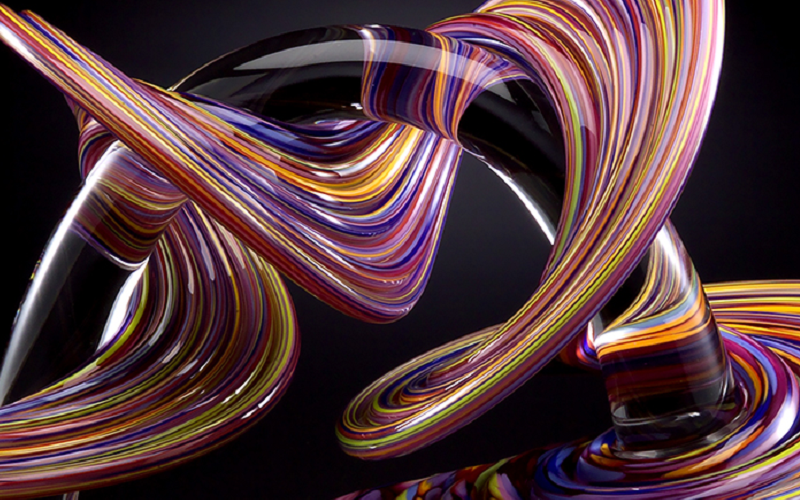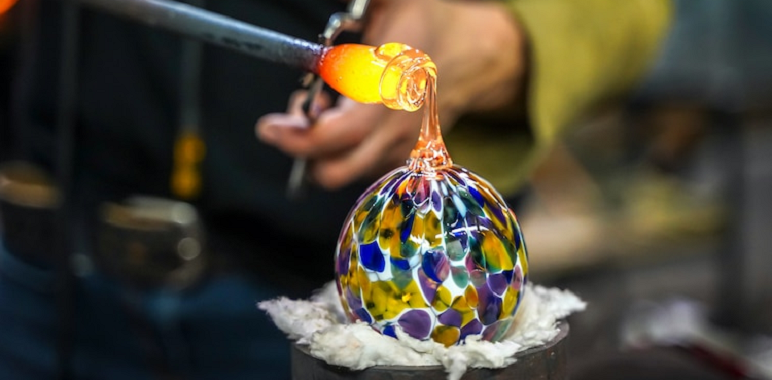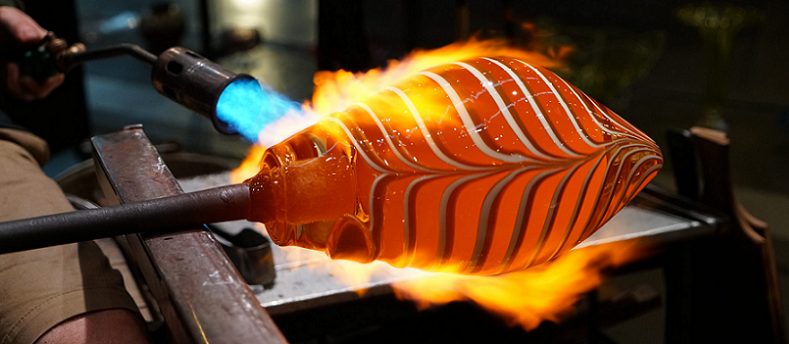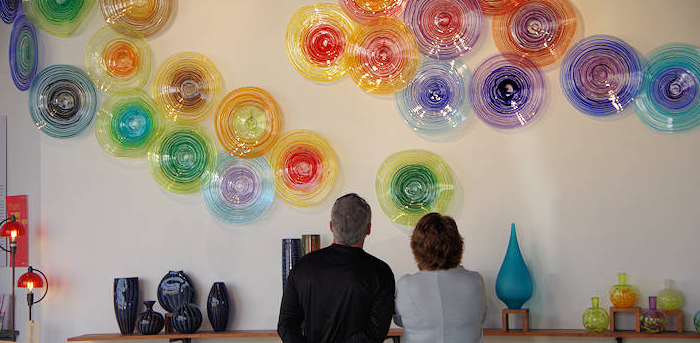
Glassblowing is a fascinating art form that has been around for thousands of years. This process involves transforming molten glass into various shapes and designs using specialized tools and techniques. The beauty and intricacy of the final product often leave people awestruck, and it’s easy to see why. Glassblowing is not only a craft, but it is also an art that requires skill, patience, and creativity. Here we explore the art of glassblowing and take a closer look at the process of creating stunning pieces of glass artwork.
What Is Glassblowing?
Glassblowing is a technique used to create objects from molten glass by shaping it with tools and manipulating it with air pressure. The process involves heating glass to its melting point, which is typically around 2000°F, in a furnace or a kiln. Once the glass is in its molten state, it is gathered onto the end of a blowpipe or a punty, which is a long, hollow rod made of metal.
The glassblower then shapes and forms the glass using various techniques and tools, such as jacks, shears, and paddles. These tools are used to manipulate the glass into the desired shape, which can range from simple spheres to complex forms with intricate designs. The glass can be stretched, twisted, and bent into various shapes using different types of tools, such as molds or blocks, which are used to help shape the glass into more defined forms.
Glassblowing is not only a technique, but it is also an art form. Glass artists use this technique to create stunning pieces of art, such as sculptures, chandeliers, and intricate glassware. The beauty and complexity of these pieces are a testament to the skill and creativity of the glassblower.
History of Glassblowing
The history of glassblowing can be traced back to the 1st century BC in the Roman Empire, where it is believed to have originated. Prior to this, glass was primarily made by casting, where glass was melted and poured into molds to create various objects. However, this process was limited in its ability to create intricate designs and shapes.
The invention of glassblowing allowed for greater flexibility and control in creating glass objects, and it quickly became the preferred method of glass production. The first glassblowers used a blowpipe and a furnace to shape and manipulate the glass. These early glassblowers were highly skilled and created objects such as cups, vases, and bowls.

As glassblowing spread throughout the world, different cultures began to develop their own unique styles and techniques. For example, the Venetians in Italy became famous for their highly decorative and ornate glasswork, while the Bohemians in Czechoslovakia specialized in creating glass beads and other small objects.
During the Renaissance, glassblowing reached new heights, and the demand for highly decorative glass objects increased. Glassblowers began to experiment with new techniques, such as the use of molds and the incorporation of gold and silver leaf into their designs.
In the 19th and 20th centuries, glassblowing continued to evolve, and new techniques and tools were developed to help glass artists create more intricate and complex designs. Today, glassblowing is practiced all over the world and has become a highly respected form of art.
The Glassblowing Process
The glassblowing process involves transforming molten glass into various shapes and designs using specialized tools and techniques. The process requires skill, patience, and creativity to master, and the results can be truly stunning. The process can be broken down into several steps.
- Gathering the Glass: The first step in the glassblowing process is to gather the molten glass onto the end of a blowpipe or a punty. The blowpipe is a long, hollow rod made of metal, while the punty is a smaller, solid rod used for support.
- Shaping the Glass: Once the glass is gathered onto the end of the blowpipe or punty, the glassblower uses various tools and techniques to shape and manipulate the glass into the desired form. These tools include jacks, shears, and paddles, which are used to stretch, twist, and bend the glass into various shapes.
- Adding Air: To add air to the glass, the glassblower places his or her mouth on the end of the blowpipe and blows a puff of air into it. The air travels down the pipe and into the molten glass, which expands like a balloon. This creates a bubble in the glass, which can be manipulated to form various shapes, such as bowls, vases, and bottles.
- Reheating: As the glass cools, it becomes more difficult to work with. To keep the glass malleable, the glassblower must frequently reheat it in a furnace or kiln. This process is known as “flashing” and involves placing the glass in the furnace for a short period of time to heat it back up to its working temperature.
- Finishing: Once the glass has been shaped and cooled to the desired form, the glassblower will use tools to smooth out any rough edges or imperfections. This may involve using a torch to heat and melt the edges of the glass, or using sandpaper to smooth it out.
- Annealing: Once the glass has been finished, it is placed in a kiln to cool down slowly. This process is known as “annealing” and helps to relieve any stress in the glass and prevent it from shattering.

Different Types of Glass Artwork
Glass is a versatile medium that can be transformed into many different forms of art. Glass artwork can be classified into various types based on the techniques and processes used to create them. Each of these types of glass artwork requires different techniques and processes, but they all share the beauty and uniqueness that glass as a medium can offer.
- Blown Glass: Blown glass is one of the oldest forms of glass art and involves blowing air into a molten glass blob using a blowpipe. This creates a bubble that can be shaped and manipulated into different forms, such as vases, bowls, and sculptures.
- Stained Glass: Stained glass is created by cutting and piecing together colored glass pieces to form a design. The pieces are then held together using lead caming or other metal frames. Stained glass is commonly used in churches and other religious buildings, but it can also be found in homes and businesses as decorative elements.
- Fused Glass: Fused glass is created by layering pieces of glass on top of each other and then heating them in a kiln until they fuse together. This process can be used to create a variety of objects, from jewelry to plates and bowls.
- Kiln-Formed Glass: Kiln-formed glass is created by placing glass pieces in a kiln and heating them until they fuse together. The resulting pieces can be flat or curved and can be used for a variety of purposes, such as wall art, sculpture, and jewelry.
- Lampworked Glass: Lampworked glass is created by heating glass rods using a torch and then shaping and manipulating them into various forms. This technique is commonly used to create glass beads, but it can also be used to create sculptures and other decorative objects.
- Cast Glass: Cast glass involves pouring molten glass into a mold and allowing it to cool and harden into the desired form. This technique is commonly used to create large-scale sculptures and architectural features.
- Etched Glass: Etched glass is created by using acid or sandblasting to etch a design into the surface of the glass. This technique is commonly used to create decorative glassware and mirrors.

Challenges of Glassblowing
Glassblowing is a challenging art form that requires a great deal of skill and precision to master. Some of the biggest challenges of glassblowing include the difficulty and danger of working with molten glass, the need for patience and practice, and the level of skill required to create beautiful pieces.
One of the biggest challenges of glassblowing is working with molten glass, which can reach temperatures of up to 2000°F. This requires extreme caution and safety measures, as the glass can cause severe burns if it comes into contact with skin. The glassblower must work quickly and efficiently before the glass cools and becomes more difficult to manipulate.
Another challenge of glassblowing is the need for patience and practice. Glassblowing is not a skill that can be mastered overnight, and it requires many hours of practice and dedication to develop the necessary skills. It can take years to become proficient in the techniques required to create complex glass objects, and even then, there is always room for improvement.
A third challenge of glassblowing is the level of skill required to create beautiful pieces. Glassblowers must have an eye for detail and the ability to manipulate the glass with precision to create intricate designs and shapes. They must also be able to work quickly and efficiently while maintaining a high level of quality in their work.
The Future of Glassblowing
The future of glassblowing is bright, with many new technologies and innovations on the horizon that will make it easier and more accessible for people to create beautiful glass artwork. One of the most promising developments is the use of computer-aided design (CAD) and 3D printing to create molds and shapes for glass objects. This technology allows glassblowers to create highly complex and intricate designs that would be difficult or impossible to create by hand.
Another area of innovation is the use of robotics in glassblowing. Robotic systems can be used to perform repetitive or dangerous tasks, such as gathering glass or blowing air into the molten glass. This allows the glassblower to focus on the more creative and artistic aspects of the process, while the robot handles the more technical and mundane tasks.
Advancements in furnace and kiln technology are also helping to improve the glassblowing process. Modern furnaces and kilns are more energy-efficient and precise than their older counterparts, which allows glassblowers to create more consistent and high-quality pieces.
In addition to technological advancements, the future of glassblowing also depends on the continued support and appreciation of the art form. As more people become aware of the beauty and complexity of glass artwork, there is a growing demand for unique and one-of-a-kind pieces. Glassblowers are also exploring new applications for glass, such as in architecture and design, which is helping to expand the reach and relevance of the art form.
The future of glassblowing looks bright, with many exciting developments and innovations on the horizon. As technology continues to evolve and the appreciation for glass art grows, we can expect to see even more stunning and intricate pieces of glass artwork in the years to come.
